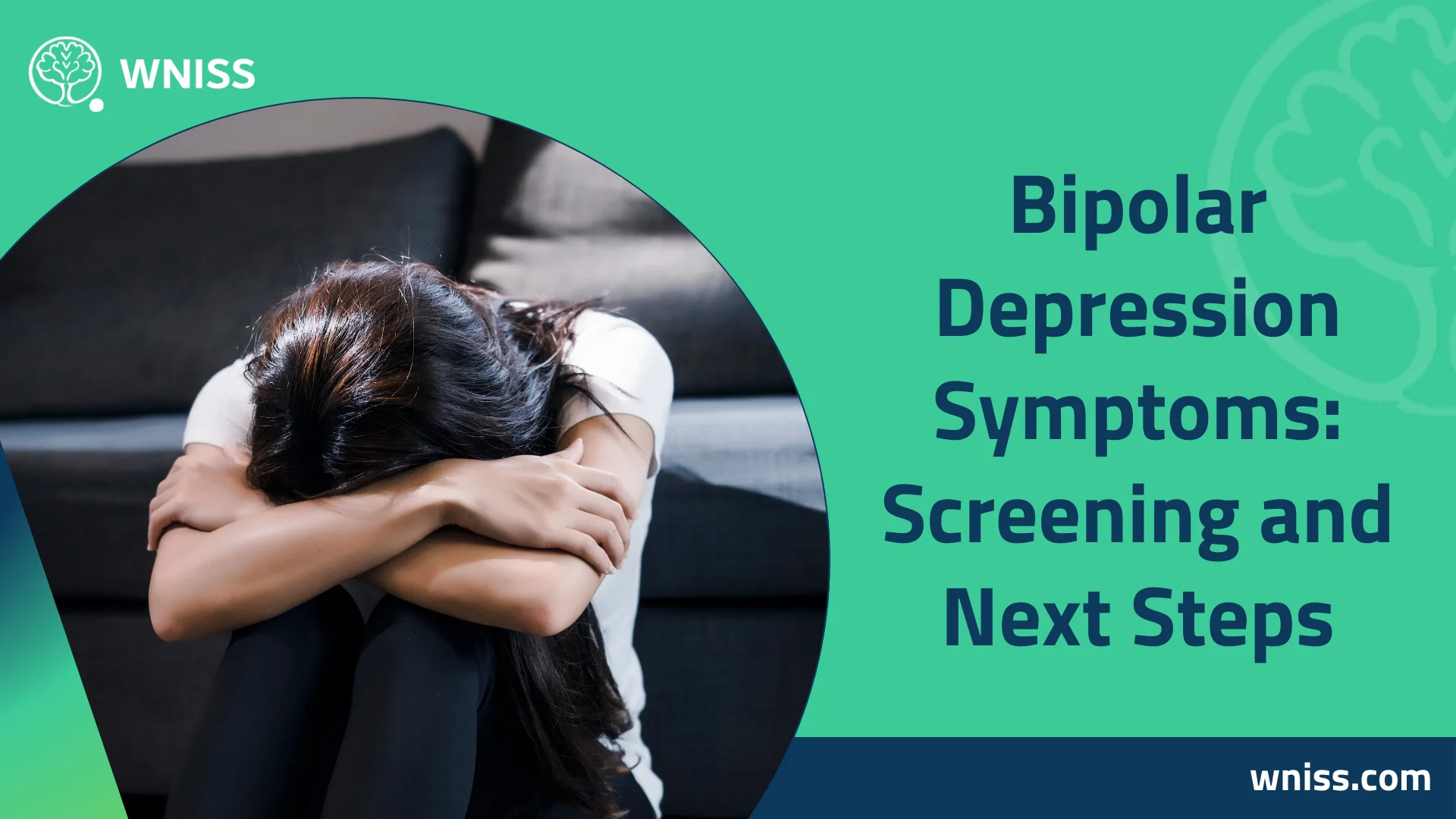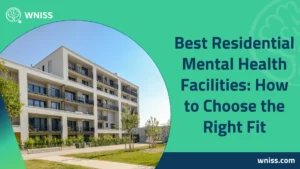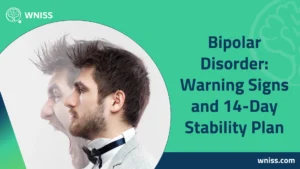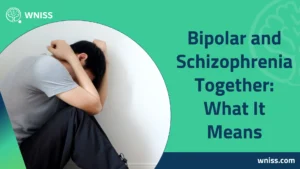When people search for bipolar depression symptoms, they’re often looking for more than a list—they want clarity and direction. Bipolar disorder brings both manic or hypomanic highs and depressive lows, but it’s usually the depression that weighs heaviest: fatigue, slowed thinking, and a shrinking sense of life. Recognizing these symptoms, understanding why they happen, and knowing which treatments truly help are key steps toward stability and recovery.
Deep Meaning of Bipolar Depression
Bipolar disorder is a cyclical mood condition—periods of “up” (mania/hypomania) and “down” (depression). Depressive episodes feel like your energy, attention, and hope budget got cut—sometimes abruptly.
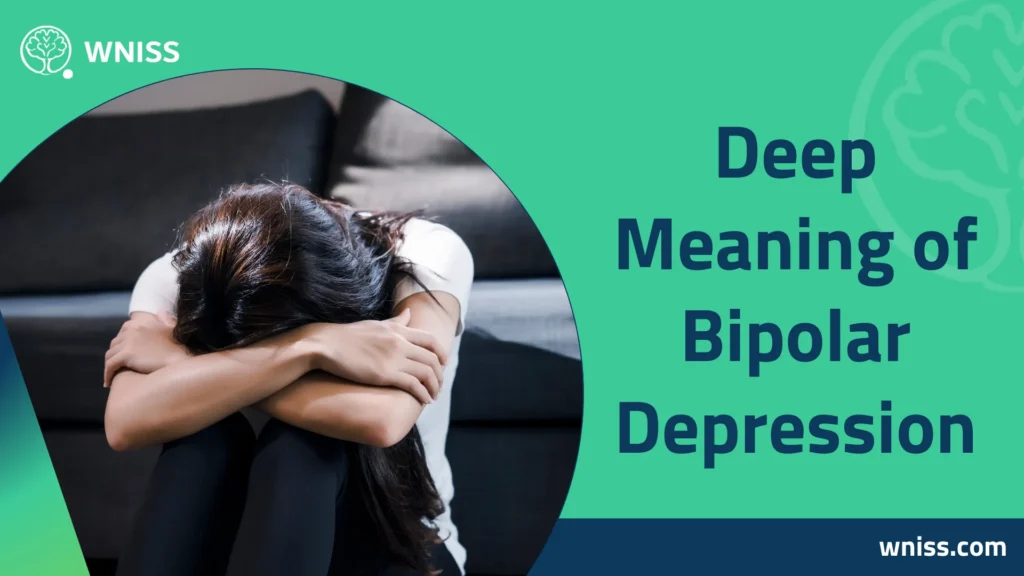
- What you’ll actually notice: persistent low mood or loss of interest, fatigue, slowed thinking, decision gridlock, and sleep/appetite changes (too much or too little). Severe episodes can include thoughts of death.
- Why it’s different from “regular” depression: there’s also a history (or risk) of activation—reduced need for sleep, faster ideas, unusually big plans—which changes medication choices and safety checks.
The Most Common Bipolar Depression Symptoms
Symptoms are best seen as patterns rather than isolated days.
Core symptoms (depression):
- Low mood or loss of pleasure most of the day
- Fatigue, slowed thinking/speech, or restlessness
- Sleep problems: insomnia or sleeping too much
- Appetite/weight changes; concentration problems; guilt or hopelessness
Red-flag combinations (raise urgency):
- Depressed mood plus racing thoughts/irritability (mixed features)
- Sleep collapsing (<6 hours for 2 nights), spending surges, or grand ideas (emerging activation)
- Any suicidal thoughts or intent → escalate immediately to urgent care
These patterns are consistent with national health resources and guideline summaries.
Why Does Bipolar Depression Happen?
There isn’t a single cause; think biology + circadian rhythm + stress + habits working together. You can’t change genetics, but you can change exposure to triggers and install routines that protect mood.
- Biology & genetics: sensitive mood–reward–sleep circuits run in families.
- Circadian disruption: irregular bed/wake times, jet lag, night shifts, and low morning light destabilize mood (this is why rhythm-based therapies help).
- Stress load: ongoing stress reduces sleep depth and resilience.
- Substances/meds: alcohol fragments sleep; stimulants and some antidepressants may destabilize mood in susceptible people—plan with a prescriber.
- Behavioral patterns: avoidance/inactivity shrink your world and reinforce low mood.
How Clinicians Diagnose Bipolar Depression
A solid evaluation ends with a plan, not just a label. Clinicians map symptoms across time and function, screen for bipolar features, and rule out medical/substance causes that mimic depression.
What the visit includes:
- Structured interview: mood, energy, sleep, speed/spending, family history, safety.
- Validated tools to track change (they don’t replace judgment).
- Rule-outs/overlaps: thyroid disease, sleep apnea, ADHD, PTSD, or substance effects.
- Specifiers: mixed or psychotic features change medication strategy and urgency. These steps align with NICE guidance on assessment/management.
Treatment That Works (and stays safe for bipolar)
The strongest outcomes come from medication + psychotherapy + rhythm protection, measured weekly so progress is visible.
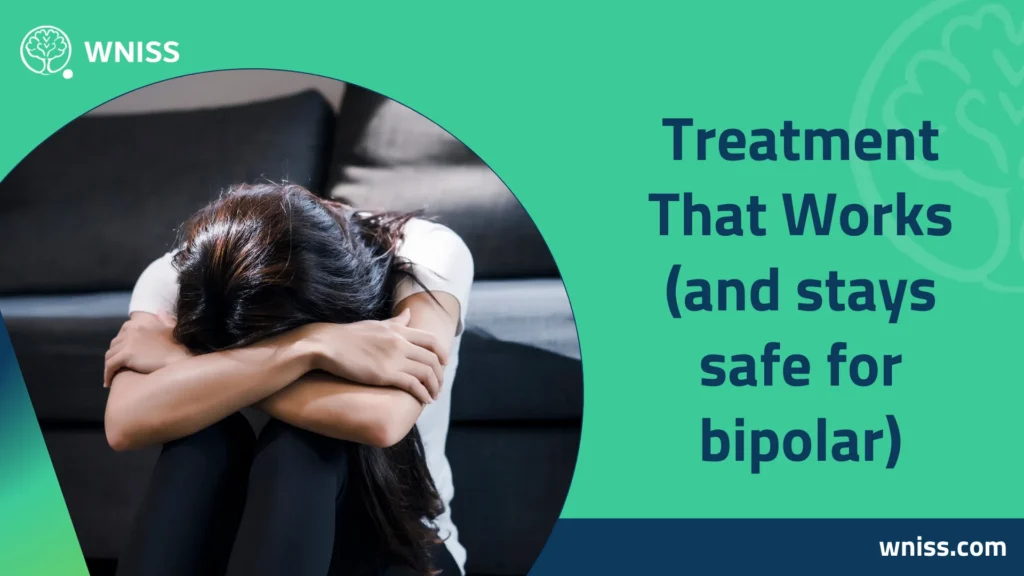
Medication (foundation):
- For bipolar depression, guidelines support options like quetiapine, olanzapine–fluoxetine, lamotrigine, and (with lithium optimization) tailored combinations. Antidepressants are not used as monotherapy in bipolar I and are contraindicated in mixed/manic states—if considered, they’re paired with a mood stabilizer and monitored for activation.
- Maintenance planning often includes lithium/atypicals with periodic review.
Psychotherapy with teeth:
- CBT (behavioral activation + cognitive tools) to push back on avoidance/pessimistic predictions.
- Interpersonal & Social Rhythm Therapy (IPSRT) to stabilize bed/wake, meals, activity blocks, and social timing—a relapse-prevention backbone with growing evidence.
- Family-Focused Therapy (FFT) to reduce conflict and write a shared early-warning/crisis plan.
- Lifestyle levers (make stability automatic): fixed sleep window (±30 min), morning light within 60 minutes of waking, earlier caffeine cut-off, brief daily movement, and a one-line nightly log (sleep hours, mood 1–10, meds taken, one “kept promise”).
14-Day Activation-Safe Plan (tiny moves, real protection)
Motivation varies; calendars don’t. Pre-decide your next two weeks so decisions aren’t left to mood at 11 p.m.
- Days 1–3 — Install anchors
- Choose a sleep window you can keep (e.g., 11:30–07:00) and hold it within ±30 minutes—even after bad nights.
- Get 10–20 minutes of morning light; add a 5–10 minute movement block (walk, stretch).
- Start a one-line nightly log and list 3 red flags (e.g., sleep <6 h ×2 nights, racing ideas, spending surge).
- Days 4–7 — Reduce noise & rehearse wins
- Caffeine last call 8+ hours before bed; devices out of bed; set a wind-down (dim → hygiene → brief reading).
- Behavioral activation: 2 tiny tasks/day (5–20 min)—one self-care, one life-admin.
- Opposite action: when urge = avoid, do the easiest version for 5 minutes.
- Days 8–10 — Add structure & support
- Block a daily “focus hour” after light/movement for the hardest task.
- Schedule two low-stakes social contacts (text/walk/coffee).
- Hold a 15-minute partner/family check-in: appreciations → what helped → one small change; confirm what triggers escalation.
- Days 11–14 — Stress-test & tune
- Simulate a late meeting or travel night; keep the same wake time next morning; use light + a short walk to reset.
- Review your log with a clinician/coach; keep two habits, tweak one friction point (earlier caffeine cut, firmer wind-down).
Feel Like Yourself Again — WNISS’s Bipolar Depression Reset (Online, Discreet, Worldwide)
When depression flattens your days, you don’t need scattered tips—you need one coordinated plan that fits your life.
- Fast online assessment (days, not months): we map your episode history, sleep, triggers, and goals—then hand you a plain-English plan for the next 2–4 weeks.
- Therapy you’ll actually use: CBT + IPSRT with micro-homework that shows up in decisions, conversations, and sleep (not just in notes).
- Medication coordination: we liaise with your prescriber for activation-safe choices, smart dose timing, and travel/shift-work sleep strategies—aligned with leading guidelines.
- Dashboards you can trust: 60-second nightly logs and weekly reviews—so progress becomes visible, not vague.
Ready to feel movement again? Book a confidential session now at WNISS and start your 14-day plan with a specialist by your side.
FAQs about Bipolar Depression Symptoms

Can I tell if I’m bipolar?
Bipolar is diagnosed clinically, not by a single quiz. Clues include episodes (days–weeks) of depressed mood or loss of interest and periods of activation (reduced sleep need, faster ideas, risky decisions). Bring a 2-week sleep/mood log to a clinician; they’ll map patterns, rule out medical causes, and discuss next steps using guideline-based care.
How does a bipolar person love?
With the same depth as anyone—what helps is structure + communication: protect sleep timing, share early-warning signs, use a 24-hour pause for big decisions during activation, and hold a weekly 15-minute check-in (appreciations → what worked → one small change). Family-focused approaches improve outcomes.
What are the top bipolar depression symptoms to watch?
Low mood or loss of interest, fatigue, sleep/appetite changes, slowed thinking, and hopelessness—plus mixed-feature red flags (depressed yet sped-up/irritable). Seek prompt care if suicidal thoughts appear.
Are antidepressants safe for bipolar depression?
They can help some people when combined with a mood stabilizer, but antidepressant monotherapy is not recommended in bipolar I and is contraindicated in mixed/manic states—your prescriber will individualize.
Which therapies work best?
Evidence supports CBT, IPSRT (rhythm-stabilizing), and Family-Focused Therapy, alongside medication and routine monitoring.
Bipolar depression symptoms are understandable, trackable, and treatable. When you treat the condition as a system—activation-safe medication choices, CBT/IPSRT delivered consistently, family alignment, and small daily anchors—stability becomes a weekly habit, not a lucky streak. Start with the 14-day plan above, track one line each night, and tune weekly. If you want a kind, coordinated roadmap that fits your life, WNISS can meet you online and help you turn good intentions into steady days—this month.
Medical References
- NIMH — Bipolar Disorder (Health Topic). Symptoms of manic and depressive episodes; public guide. المعهد الوطني للصحة العقلية+1
- NICE CG185 — Bipolar disorder: assessment and management. Recommended treatments for bipolar depression and assessment steps. NICE+1
- CANMAT/ISBD (2018) — Bipolar Treatment Guidelines. Pharmacologic and psychosocial recommendations across phases. PMC+2canmat.org+2
- APA — What Are Bipolar Disorders? Patient-friendly overview of treatment and management. Psychiatry
- Evidence-Based Psychotherapies for Bipolar Disorder. Review supporting CBT, IPSRT, and Family-Focused Therapy. PMC
- IPSRT Evidence Summaries. Research describing rhythm-based therapy effects and rationale. PMC+1
- AAFP Clinical Review (2021). Notes that antidepressant monotherapy is contraindicated in bipolar I, mixed, or manic states. AAFP

